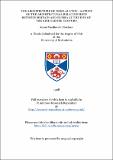Files in this item
The architecture of Nikolai L'vov : a study of the architectural relationships between Britain and Russia at the end of the eighteenth century
Item metadata
| dc.contributor.advisor | Howard, Jeremy | |
| dc.contributor.author | Makhrov, Alexei Vasilievich | |
| dc.coverage.spatial | 2 v, (376 p, 128 p) | en_US |
| dc.date.accessioned | 2018-07-11T14:45:25Z | |
| dc.date.available | 2018-07-11T14:45:25Z | |
| dc.date.issued | 1998 | |
| dc.identifier.uri | https://hdl.handle.net/10023/15265 | |
| dc.description.abstract | The thesis offers a reassessment of the works of the Russian architect Nikolai Alexandrovich L'vov (1751-1803). His designs are examined in the context of European architecture. Sources of inspiration for his advanced Neo-Classical style are found in monuments of Greek and Roman antiquity, Renaissance architecture and works of British, French and Italian architects, such as Charles Cameron, Adam Menelaws, Ennemond-Alexandre Petitot and Giacomo Quarenghi. The comparative analysis of L'vov's works with designs of his Russian and foreign contemporaries, for instance Matvei Kazakov, Adrean Zakliai'ov, John Soane, Claude-Nicolas Ledoux and others, highlights the innovative character of L'vov's designs. The investigation of the works produced by L'vov for Catherine the Great, Paul I and the powerful statesman Alexander Bezborodko demonstrates that the architect was entrusted to express political concepts, such as the 'Greek Project', Catherine's plan to liberate Constantinople from the Turks. It is argued that his public buildings and garden scenery of the park of Bezborodko in Moscow were designed as propaganda tools to influence people. The discussion focuses on the consideration of L'vov's interpretation of the ideas derived from European architecture. For example, L'vov was the first Russian architect to declare himself a follower of Palladio. The pioneering study of the Medieval architecture of Moscow produced by L'vov was parallel to the development of the preservationist attitude to national heritage in Britain. He produced ingenious engineering ideas, such as that of the double-shelled dome influenced by the examples of antique and French architecture and adapted to the requirements of Russian climate. He also introduced to Russia the modernised method of building from earth, derived from a French source and modified with the assistance of his Scottish associates. By analysing the relationships between the architecture of L'vov and that of Britain and other European countries, this study seeks to establish his reputation as one of the outstanding European architects of the late eighteenth century. | en_US |
| dc.language.iso | en | en_US |
| dc.publisher | University of St Andrews | |
| dc.subject.lcc | NA1186.L8M2 | en |
| dc.subject.lcsh | Architecture--Russia--19th century. | en |
| dc.title | The architecture of Nikolai L'vov : a study of the architectural relationships between Britain and Russia at the end of the eighteenth century | en_US |
| dc.type | Thesis | en_US |
| dc.contributor.sponsor | Russell Trust | en_US |
| dc.contributor.sponsor | Gapper Foundation | en_US |
| dc.contributor.sponsor | Cookie Matheson Trust | en_US |
| dc.type.qualificationlevel | Doctoral | en_US |
| dc.type.qualificationname | PhD Doctor of Philosophy | en_US |
| dc.publisher.institution | The University of St Andrews | en_US |
This item appears in the following Collection(s)
Items in the St Andrews Research Repository are protected by copyright, with all rights reserved, unless otherwise indicated.

